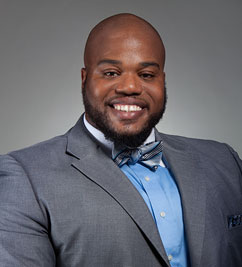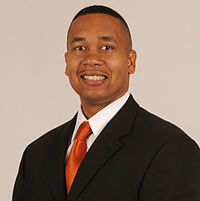Creating a Computer Science Pipeline for African Americans
April 28, 2014

LaVar J. Charleston
The number of African American faculty teaching computer science in higher education is alarmingly low, according to LaVar J. Charleston.
“You can go through your entire scholarly trajectory in computer science without seeing one face of color,” Charleston said.
Charleston, assistant director of Wisconsin’s Equity and Inclusion Laboratory (Wei LAB), is the lead author of a recent paper investigating the benefits of the newly created Institute for African-American Mentoring in Computing Sciences (iAAMCS) headquartered at Clemson University, but having national reach. Wei LAB is housed within WCER and, in its role as an iAAMCS partner, will comprehensively research and evaluate iAAMCS.
Research in 2011 by Charleston and Wei LAB director Jerlando F. L. Jackson, showed mentoring to be an effective method of broadening participation for faculty in science, technology, engineering, and math (STEM). In 2013, the National Science Foundation awarded a $5 million, 5-year grant to Clemson University and its partners to create iAAMCS, with mentoring as the unifying framework of a program designed to increase the number of African American graduate students, faculty, and researchers in computing.

Juan E. Gilbert
Charleston’s paper, “Creating a Pipeline for African American Computing Science Faculty: An Innovative Faculty/Research Mentoring Program Model,” is coauthored by Clemson Professor of Computing Juan E. Gilbert, as well as Wei LAB graduate student Barbara Escobar, and Jackson. It was published in The Journal of Faculty Development, and represents Wei LAB’s initial foray into examining the effectiveness of iAAMCS, which launched in November 2013.
According to Charleston, iAAMCS has enormous potential to draw minority students into computer science and to sustain their interest in the field, increasing the likelihood that more of them will eventually become computer science faculty members.
“The iAAMCS employs a robust definition of mentorship, incorporating peer-to-peer interaction and accountability, technology-assisted communication, social contacts and networking, and career advice and encouragement,” Charleston said. “The methods the institute is using have been proven to be effective individually, but iAAMCS is capitalizing on bringing them all together; it’s multifaceted mentoring.”

According to Gilbert, co-director of iAAMCS, African American students have an interest in STEM disciplines at the same rate as their White counterparts through elementary school, but their level of interest and participation in STEM deteriorates as they get older. At the post-baccalaureate level—the target area for iAAMCS—less than one percent of students in STEM fields in graduate school are African American.
“The pipeline has a lot of holes in it,” Gilbert said. “We’re trying to fix one of those leaks.”
“Misunderstandings about STEM among African American students are a cause for the drop off in interest,” Gilbert said.
“There’s a belief that STEM scholars work only with phenomena and artifacts, not with people,” Gilbert said. “African Americans are heavily concentrated in helping professions—in areas that work intensively with people. So it’s important for us to highlight how computing can be used to help others, how it can have a direct impact on society.”
Another harmful stereotype—that computing is exclusively for White men—is truer than many care to believe, added Charleston.
“For as long as the field has been around, it has largely been dominated by White men,” Charleston said. “A common thread is that African Americans don’t feel like there’s a welcoming place for people of color in STEM—particularly women of color. That’s why it’s so important to build up the numbers of minority STEM faculty, because if students don’t see anybody who looks like them doing what they want to do, they’re less likely to feel like they belong. On the other hand, if you feel like you’re a part of a community of folks working towards a common goal who might look like you or come from a similar background, you are more likely to strive and persist.”
The iAAMCS program emphasizes creating and maintaining peer mentoring relationships between minority students in computer science. The program includes weekly forums to discuss issues such as academic preparation, time management, networking, career advancement, and funding. It also includes a web-based system that allows participants to post and track their personal goals and encourage peers.
Another important aspect of the program is its effort to connect minority students with minority faculty members. Graduate students who find a mentor in their chosen profession are more likely to become integrated into a department, cultivate professional networks, acquire competency in research practices, and find work after earning their degree.
“Mentors give students a much better understanding of what it means to have a degree in computer science, how to get the degree, and walking that pathway,” Charleston said. “Exposure to a mentor, or several mentors a student can trust, is a critical factor in promoting their success throughout their educational trajectory.”
Connecting minority students and faculty is not easy, Charleston noted, as his research found there are only 56 Black tenure-track faculty members in computer science programs at Ph.D.-granting institutions nationwide, and just 172 Black students enrolled in computer science Ph.D. programs. The iAAMCS seeks to increase those numbers through the use of a web-based community that connects computing students and faculty at institutions of higher education across the country. The institute is designed to function as a “virtual hub of resources” for faculty development and mentorship in computing, aiding individual institutions that either have fledgling efforts at minority faculty and graduate student development, or lack such efforts entirely.
“If you’re an African American student wanting to pursue a computing degree, finding an African American role model is not easy. With fewer than 60 faculty in the country to choose from, the probability of finding one is really small,” Charleston said. “The iAAMCS is trying to break down that barrier.”
Less than 1 year into the iAAMCS project, Gilbert is pleased with how the institute is running, but he said it may take the full length of the grant to “move the needle” on the number of minorities becoming computer science faculty. Wei LAB will be essential in that effort, he added.
“The iAAMCS program is designed to create some structures that have long-term effects, and ideally to create a broader impact,” Gilbert said. “In order to scale up this project, we need evidence these practices we’re implementing work, and Wei LAB will be instrumental in evaluating our program to find that evidence.”


